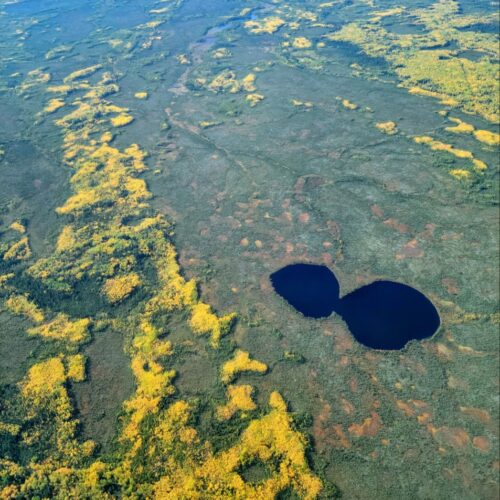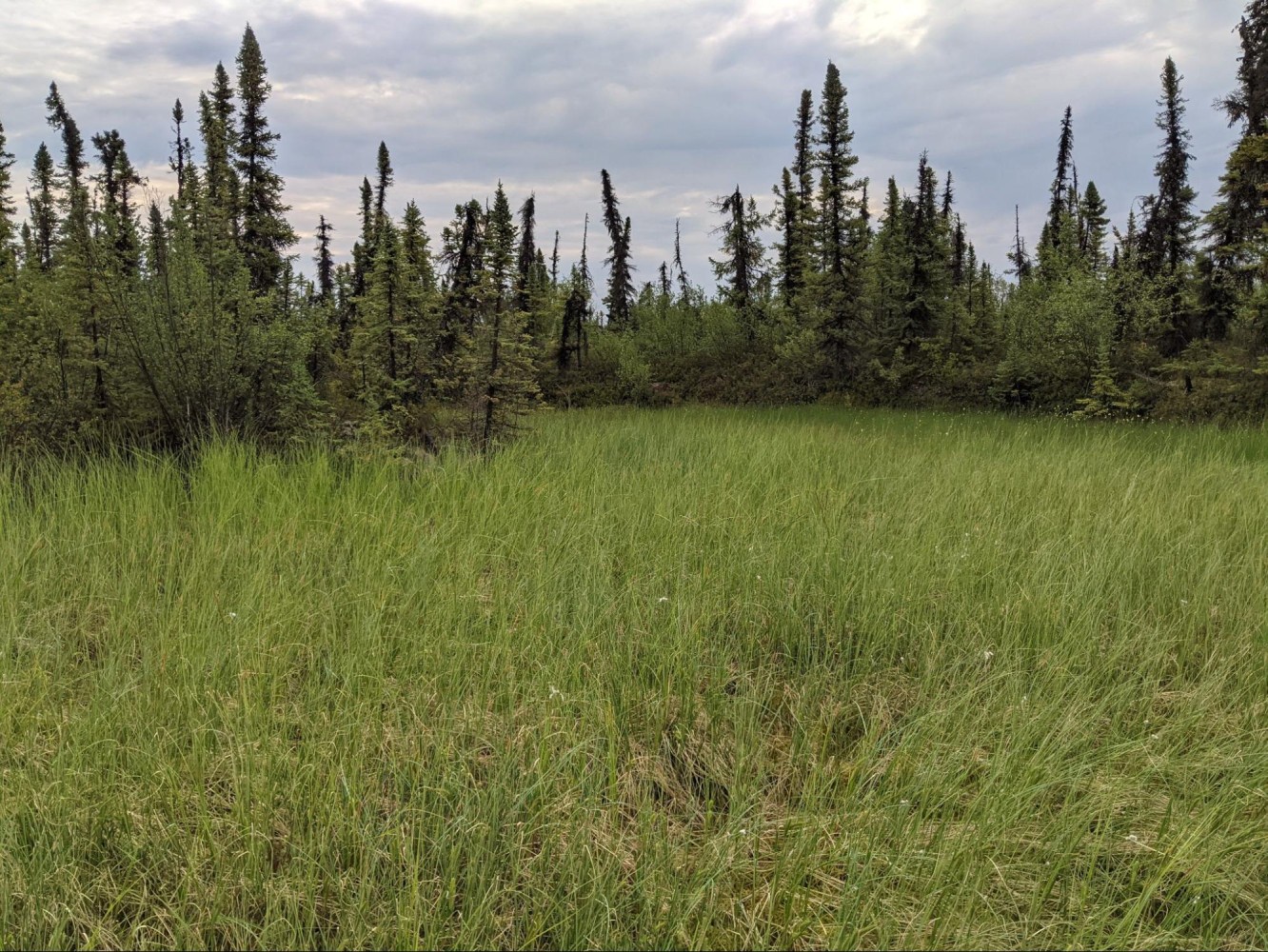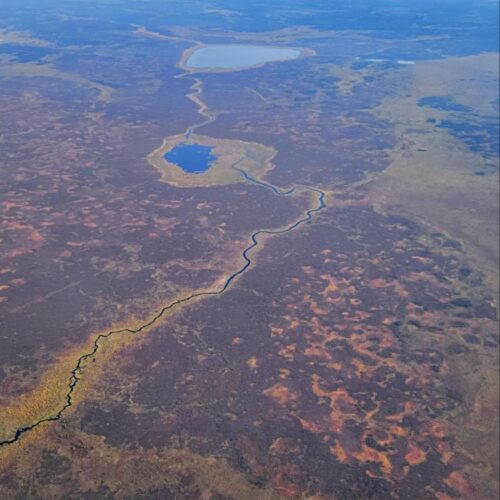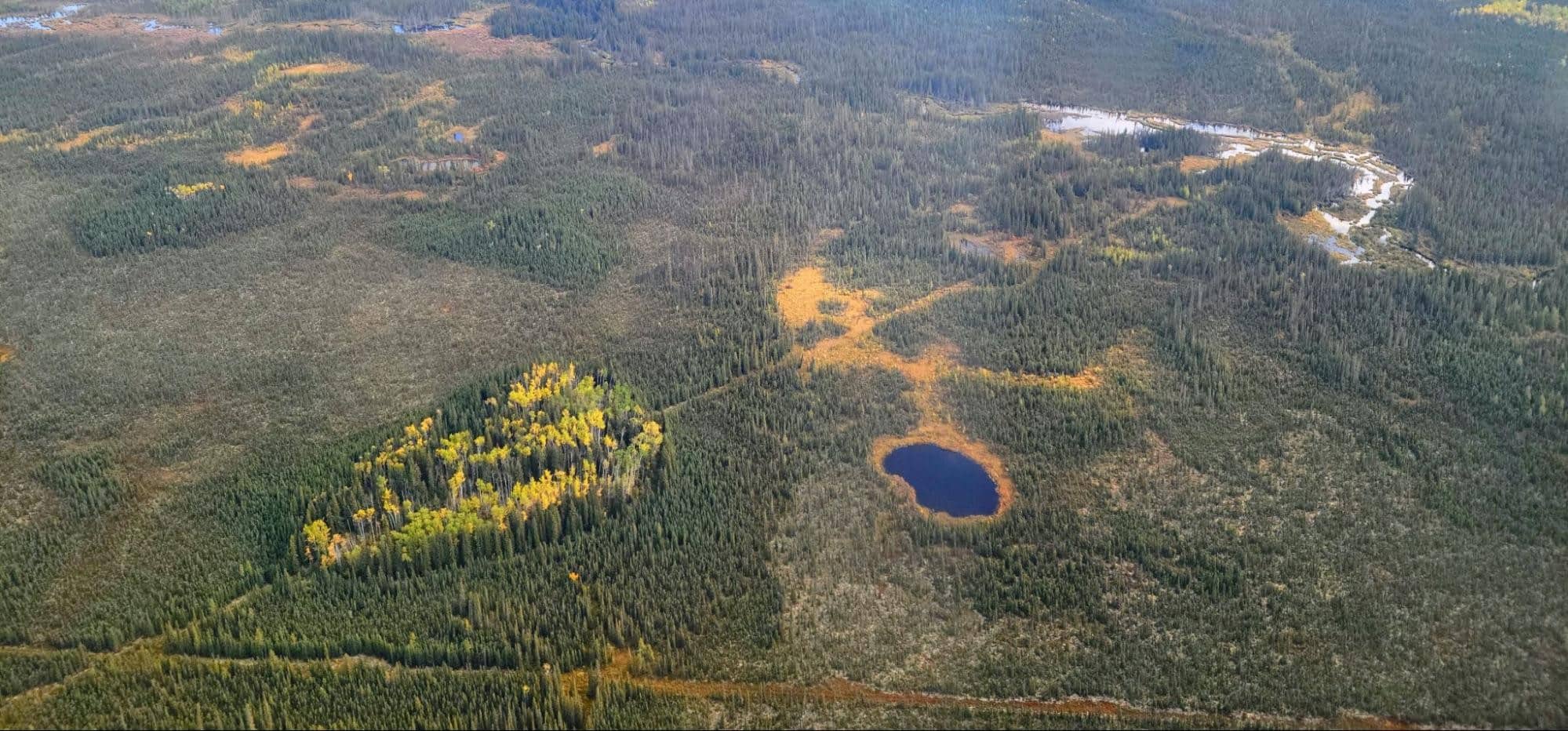Meet peat: A climate, biodiversity, and culture hero.
By Lauren Thompson
Picture this – a low hum of mosquitoes in the air; a fragrant, stirring breeze breaks the stillness alongside the squish of rubber boots on soggy ground. You lift up your bug net to take a bite of sweet blueberries or floral, tangy cloudberries, stopping every few meters to pick as you walk.
Beneath your feet lay several meters of partially decomposed plants and mosses that have been piling up for millennia after retreating glaciers left poorly draining sedimentary rocks in their wake. A perfect spot for ecosystem engineers like Sphagnum moss to slowly and steadily grow on soggy ground, drawing carbon down from the atmosphere as they flourish. Hello, peat.

Peatlands cover large swaths of the Taiga Plains ecozone, Canada’s second-highest density peatland region after the Hudson Bay Lowlands. Indigenous nations in the Taiga Plains have deep connections with peatlands, commonly known as muskeg. Communities have harvested and managed medicines and food in the muskeg since immemorial.
Indigenous-led conservation across the country is blazing a trail to protect peatlands from disturbance. These projects address direct threats like peat mining, oil and gas extraction and secondary threats like expanding road networks for forestry (learn more here: Bistcho Lake, Seal River Watershed, Lac La Ronge).
Getting to know plateaus, bogs, and fens
Several peatland types have developed in the Taiga Plains: peat plateaus, bogs, and fens. From an aerial view, peat plateaus are easily identifiable by their sparse black spruce cover and the sheen of pale lichen, often surrounded by wetter bogs and fens. In the boreal mosaic, peatlands are distinct from patches of upland forests with mixed deciduous and coniferous cover.


In the Taiga Plains, many peatlands have an icy secret that you wouldn’t necessarily detect from walking on their surface. The peat plateaus that dot the landscape are drier and slightly elevated above bogs and fens. Underneath the black spruce, springy green lichen, patches of shrubs, and mounds of Sphagnum lie permafrost – ground that is frozen year-round. Boreal caribou, which have immense cultural significance and face threats to survival across Alberta, favor peat plateaus to munch on lichens, particularly in winter 1.
Lenses of ice lift the plateaus above their surrounding landscape. The frozen peat is protected by the slightly dry surface of peat plateaus, which thermally buffers warm summertime air like a styrofoam cooler keeping your popsicles frozen. Indeed, Indigenous communities have long used permafrost like a fridge to preserve foods. The permafrost is further protected after autumn rain saturates the peat and enhances thermal conductivity, allowing winter air to easily penetrate the surface layer3.
Bogs and fens, on the other hand, are wetter landforms than peat plateaus and do not have underlying permafrost. In the Taiga Plains, bogs are dominated by Sphagnum mosses that span every colour imaginable (bright green, dark green, red, purple, orange!) alongside shrubs and black spruce.
Since bogs receive water solely from rain, snow, or some runoff from plateaus, competition for nutrients is fierce. In bogs, you come eye-to-eye with carnivorous plants like delicate sundews or undulating pitcher plants that thrive in this nutrient-limited environment by ensnaring bugs. Fens are fed by groundwater in addition to surface runoff or precipitation, leading to richer vegetation in the form of tall sedges, shrubs, and brown mosses4. You better have waders or boardwalks if you’re in a fen or bog! You may also spot moose enjoying willows and shrubs in these soggy peatlands2.


Permafrost dynamics in the Taiga Plains
Peatlands are dynamic environments and are adept historical archives if you extract a core from their depths as peatland scientists often do. The dance between water, microbes, and vegetation is laid bare under the microscope back in the lab. Site histories can be reconstructed from plant macrofossils and age-dating peat samples with radiocarbon analysis. In the northern Alberta regions of the Taiga Plains, peatlands began to develop as fens in landscape depressions about 8,000 years ago, with widespread bog development atop the fens in response to cooler and wetter climates about 5,000 years ago, coinciding with the initiation of permafrost conditions5.


Cycles of permafrost degradation and re-establishment have occurred naturally for thousands of years in the Taiga Plains, with thaw often triggered by wildfire, after which peat re-accumulates and supports frozen conditions anew5. Industry secret: permafrost scientists say thaw instead of melt – since we are talking about a combination of soil, rock, and water that is defrosting. In today’s climate, permafrost thaw is rapidly accelerating from extreme warming and intensification of wildfire frequency and intensity6. When permafrost thaws today, there is no turning the freezer back on.
Permafrost is like a long-term savings account for the climate- tons and tons of frozen carbon locked away, inaccessible to microbial decomposition. Permafrost thaw spends these savings as the ground warms, introducing a carbon-rich food source to microbes, culminating in the emission of greenhouse gases like carbon dioxide or methane back into the atmosphere7.
These emissions from thaw have been described as a ‘country of permafrost,’ where plausible outcomes of Arctic warming will be equivalent to adding another high-emitting country to our world’s greenhouse gas budgets by the end of the century8.
Threats to peatlands of Northern Alberta
Planned industrial activity in Northern Alberta will only accelerate thaw further with road networks and linear disturbances that compact, saturate, and warm the peat9. Wide-ranging consequences will arise for climate, biodiversity, and cultural connections forged since time immemorial. To enable their role as a natural climate solution, peatlands simply must be left intact.
Regional planning in northern Alberta also welcomes peat mining (the drainage and extraction of these peatlands) for horticultural soil amendment. Optimal caribou habitat is beginning to disappear with the thawing of peat plateaus. Traversing the land to harvest food and medicine is becoming more difficult for Indigenous Peoples, and using natural permafrost ‘freezers’ to preserve food is less reliable – not to mention concerns about the possible mobilization of contaminants previously locked in permafrost.
As a refuge of permafrost, a carbon sink, and home to threatened plants and animals, the local and global impacts of peatland disturbance in Alberta and throughout the Taiga Plains can’t be understated. The critical work of Indigenous guardians to monitor ongoing change to lands and waters in the peatlands alongside Indigenous-led conservation efforts provides a path forward to protect and manage these precious ecosystems.

Bonus tips: Embrace peat-free gardening this spring
The peat-free gardening movement is gaining momentum in consideration of the global importance of peatlands. Almost every bag of potting soil you can buy contains Sphagnum moss extracted from peat mining operations, often marketed as peat moss. Peat-free alternatives are slowly becoming more popular in Canada but can still be tricky to find. If you cannot locate peat-free potting soil this spring, you can make your own! Mix up 2 parts coconut coir (make sure to hydrate if it’s in a large, dry block), 1 part compost or worm castings, and 1 part perlite or vermiculite, and store in a sealed container. Happy gardening – the bogs will thank you.
References
(1) Storeheier, P. V.; Mathiesen, S. D.; Tyler, N. J. C.; Olsen, M. A. Nutritive Value of Terricolous Lichens for Reindeer in Winter. The Lichenologist 2002, 34 (3), 247–257. https://doi.org/10.1006/lich.2002.0394.
(2) Routh, M. R.; Nielsen, S. E. Dynamic Patterns in Winter Ungulate Browse Succession in the Boreal Plains of Alberta. Forest Ecology and Management 2021, 492, 119242. https://doi.org/10.1016/j.foreco.2021.119242.
(3) Wright, S. N.; Thompson, L. M.; Olefeldt, D.; Connon, R. F.; Carpino, O. A.; Beel, C. R.; Quinton, W. L. Thaw-Induced Impacts on Land and Water in Discontinuous Permafrost: A Review of the Taiga Plains and Taiga Shield, Northwestern Canada. Earth-Science Reviews 2022, 232, 104104. https://doi.org/10.1016/j.earscirev.2022.104104.
(4) Vitt, D. H.; Chee, W.-L. The Relationships of Vegetation to Surface Water Chemistry and Peat Chemistry in Fens of Alberta, Canada. Vegetatio 1990, 89 (2), 87–106. https://doi.org/10.1007/BF00032163.
(5) Zoltai, S. C. Cyclic Development of Permafrost in the Peatlands of Northwestern Alberta, Canada. Arctic and Alpine Research 1993, 25 (3), 240–246. https://doi.org/10.1080/00040851.1993.12003011.
(6) Gibson, C. M.; Chasmer, L. E.; Thompson, D. K.; Quinton, W. L.; Flannigan, M. D.; Olefeldt, D. Wildfire as a Major Driver of Recent Permafrost Thaw in Boreal Peatlands. Nat Commun 2018, 9 (1), 3041. https://doi.org/10.1038/s41467-018-05457-1.
(7) Harris, L. I.; Richardson, K.; Bona, K. A.; Davidson, S. J.; Finkelstein, S. A.; Garneau, M.; McLaughlin, J.; Nwaishi, F.; Olefeldt, D.; Packalen, M.; Roulet, N. T.; Southee, F. M.; Strack, M.; Webster, K. L.; Wilkinson, S. L.; Ray, J. C. The Essential Carbon Service Provided by Northern Peatlands. Frontiers in Ecol & Environ 2022, 20 (4), 222–230. https://doi.org/10.1002/fee.2437.
(8) Schuur, E. A. G.; Abbott, B. W.; Commane, R.; Ernakovich, J.; Euskirchen, E.; Hugelius, G.; Grosse, G.; Jones, M.; Koven, C.; Leshyk, V.; Lawrence, D.; Loranty, M. M.; Mauritz, M.; Olefeldt, D.; Natali, S.; Rodenhizer, H.; Salmon, V.; Schädel, C.; Strauss, J.; Treat, C.; Turetsky, M. Permafrost and Climate Change: Carbon Cycle Feedbacks From the Warming Arctic. Annu. Rev. Environ. Resour. 2022, 47 (1), 343–371. https://doi.org/10.1146/annurev-environ-012220-011847.
(9) Dabros, A.; Pyper, M.; Castilla, G. Seismic Lines in the Boreal and Arctic Ecosystems of North America: Environmental Impacts, Challenges, and Opportunities. Environ. Rev. 2018, 26 (2), 214–229. https://doi.org/10.1139/er-2017-0080.
About the Author
Lauren is a PhD candidate in Land and Water Resources at the University of Alberta, studying the effects of permafrost thaw on mercury cycling in peatland catchments on Dehcho First Nations and Dene Tha’ lands.
Stay updated on Conservation in Alberta
Take Action
The Biggest Coal Risk to Date: New Coal Policy Direction in Opposition to Albertans' Values
Government of Alberta MUST develop a coal policy that protects Albertans and our Future
Over the past five years, Albertans have been loud and clear that they oppose ANY new coal exploration or mining in Alberta’s Rocky Mountains and Eastern Slopes. Tens of thousands came together for a collective, concerted push against the Government of Alberta's recission of the 1976 Coal Policy and the subsequent mine exploration, which was successful in forcing the province to implement a moratorium in 2022.
STAY INFORMED
Protect the Wilderness
To receive news and updates from CPAWS Northern Alberta, including opportunities to get involved, join our mailing list below.
